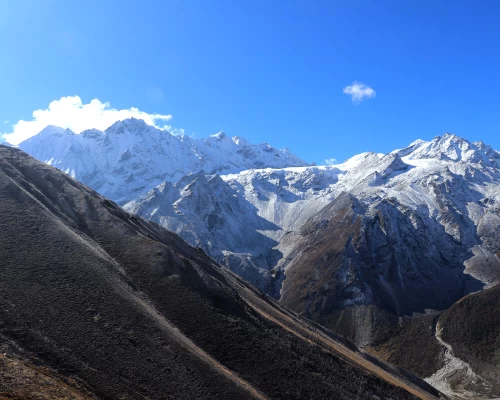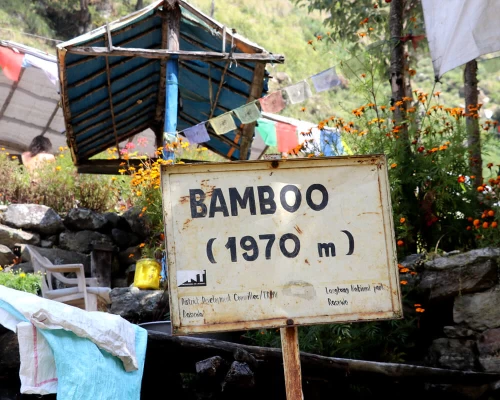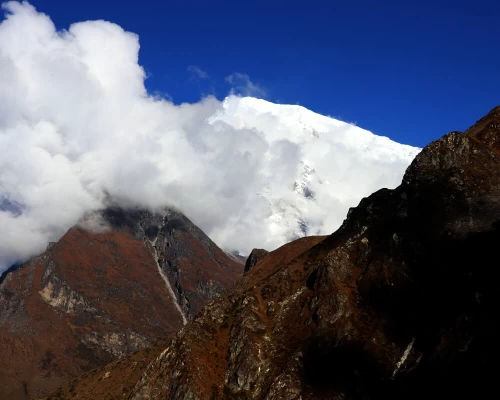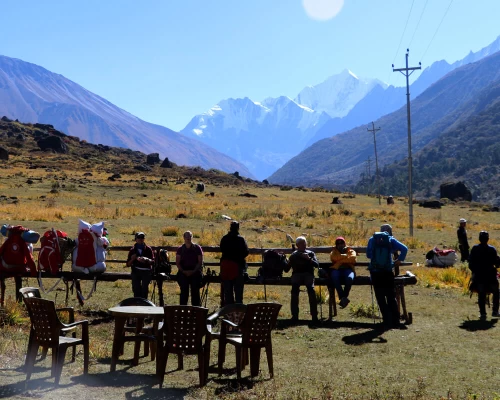Our Langtang Circuit Trekis an adventurous journey through jungle-like forests, terraced hillsides, and up to the glacial Langtang Valley. The trail captures every great wonder that the Langtang National Park has to offer. The sacred Gosaikunda Lake, one of the main attractions of this trek, is a famous pilgrimage site of both Hindu and Buddhist devotees. Hindu mythology considers the lake to be a dwelling place of the deities Shiva and Gauri and therefore the Gosaikunda lake trek is a popular hike option. Located at 4380 meters above sea level, visitors (including ourselves) feel blessed to reach there.
Wildlife found in Langtang National Park includes the Himalayan black bear, the Himalayan tahr, the gray catarrhine monkey, musk deer, the snow leopard, and the famously rare Red Panda – a sign of a thriving ecosystem. On top of the already amazing flora & fauna, and wonderful diverse landscapes, the natives of the region make this trek all the more enchanting. The culturally rich Tamang ethnic group, native to Tibet, is known for being welcoming and hospitable, facilitating a peaceful and joyful trekking experience. For a solid cultural adventure, you can also consider our Tamang heritage Langtang Valley Trek.
Overview of the Langtang Circuit Trek
We begin the trek in Syabrubesi after a 7-8 hour drive from Kathmandu. The trail then follows the river upstream through bamboo, pine, and rhododendron forests. Eventually, after passing through Langtang Valley, we arrive at the alpine meadows of KyanjinGompa, where we are greeted with spectacular mountain views. We explore the monastery and sample yak-milk Swiss cheese from one of the oldest cheese factories in Nepal. We have several options for day hikes in the area. We can hike to TserkoRi(5000m)– a vista that offers majestic views of over 21 peaks! Other options are hiking to KyanjinRi (4773m) for an incredible lookout point, or LangshishaKharka to relax with the yaks and take in the mountain air.
After traversing the breathtaking Laurebina La (4610m) pass, we descend toward the sacred Gosaikunda Lake(4380m). The following day, we arrive at the magnificent Lake, where we stay for the night and explore the following day. This holy body of water becomes especially significant during the Janai Purnima festival. During this particular festive season, the religious Pach Pokhari Trek in the Langtang region is quite on-demand. Every August full moon, thousands of pilgrims come from Nepal and India and flock to the lake to partake in the festivities. It is a time when, among other rituals, Hindus change the sacred thread wrapped around their bodies and bathe in the crystal blue waters. For many pilgrims, this is a once-in-a-lifetime occurrence, and you will feel the radiating energy of excitement just from being there. If you have the opportunity to trek during this time, don’t miss it!
After a few more days of trekking to and through extraordinary mountain villages, we arrive in Sundarijal and take the bus back to Kathmandu. Just in case, 16 days feels a lot for you, we have a better alternative package for you; the 6-Day Langtang Valley Trek.
Trekking is possible throughout the year, but Spring (March to May) and Autumn (September to November) provide the best weather. During the Spring, there is a bit more color and the rhododendrons are blooming, and in the Autumn months, the skies are generally clearer. The Langtang Circuit Trek requires fitness and acclimatization to avoid acute mountain sickness. Breeze Adventure arranges the trek with complete management. Please, feel free to contact us for more detailed information. Also, check out our beginner-friendly Nepal trek packages.
Why the Langtang Circuit Trek is a Must-Do in 2024/202?
A Hidden Gem in the Himalayas
The Langtang Circuit trek is a less-explored trekking trail of Nepal, a hidden gem of the Nepali Himalayas. If you like to engage more with nature and not the crowds, this circuit trek in the Langtang region is a perfect option for your next hike in 2024/2025. This hike provides an ideal fusion of stunning scenery, engaging with the local culture, and a sense of peace that is hard to find on the more crowded trails.
Cultural Immersion in the Langtang Valley
One of the features of this Langtang circuit trek that makes it the best trekking trail in Nepal for 2024/2025 is the cultural encounters throughout the journey. The Tamang people live in the Langtang Valley, and their culture—which has been greatly impacted by Tibetan customs—offers an intriguing window into living in the Himalayas. Along the way, you'll get to meet friendly locals who reflect the area's long tradition and discover traditional towns, historic monasteries, and even the process of making local Nepali cheese. With our Tamang heritage trek option, you can explore the local culture of Langtang and fully immerse in it.
A Region Reborn: Post-Earthquake Revival
The Langtang Circuit Trek in 2024/2025 offers a chance to see an area that is still quite isolated and generally unexplored by tourists. Trekking activity in the region declined after the 2015 earthquake, however, the trail has since been repaired and is safe for travelers. It's the ideal time to take the walk because the natural landscape has been able to flourish during this recovery phase. Just make sure you have a brief idea about the trek's difficulty before starting your journey. Reading blogs about the Langtang trek difficulties could help you.
A family-friendly trek option
Families looking for a shared Himalayan adventure can consider the Langtang Circuit Trek. Trekkers of all ages, including younger ones, can visit it due to its well-maintained routes and moderate challenge. The hike offers an enjoyable getaway for everyone by combining beautiful landscapes, cultural interactions, and practical daily phases. Every family member will have a memorable experience with the authentic tea houses' coziness and the friendly hospitality of the surrounding towns.
Packing Tips for the Langtang Circuit Trek
- Layering Clothes: Pack warming mid-layers, moisture-wicking base layers, and breathable, waterproof outer shell clothes to be ready for any kind of weather. This will allow you to adjust to changing temperatures and conditions.
- Ideal Footwares: To avoid discomfort, carry strong, water-resistant hiking boots that provide enough ankle support. Additionally, break them in before the hike.
- Sleeping Essentials: Although the tea houses offer simple bedding, a lightweight, cold-weather sleeping bag will help you just in case.
- Trekking Poles: Vital for stability, these can reduce joint stress and enhance your balance on difficult terrain.
- Sun Safety: Because sun exposure increases at high elevations, shield yourself from the sun with high-quality sunglasses, sunscreen, and a wide-brimmed hat.
- Hydration and Snacks: Pack a filter or purification tablets in a reusable water bottle. To maintain your energy levels, bring high-energy snacks like energy bars and trail mix.
- Personal care: Bring along a small first aid kit, a camera, and any prescription medicines you might need. It's also essential to have a torch or flashlight with extra batteries.
- Functional Backpack: To keep your belongings safe from the weather, choose a lightweight, ergonomic backpack that has enough room and a rain cover.
One Additional tip for the trek, prepare and get your Langtang Valley trek permits in advance for an easy and convenient trip.







